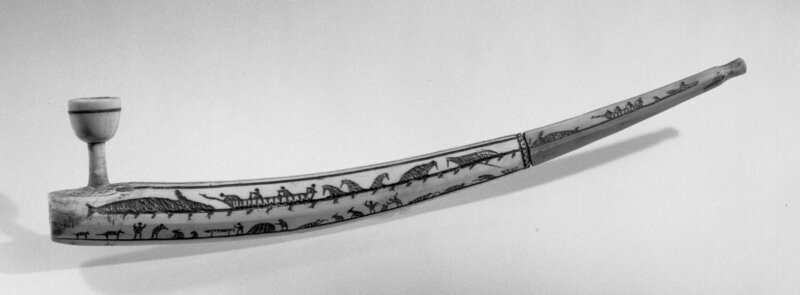Pipe Item Number: 22.1797 from the Brooklyn Museum

Description
This is a curved pipe with a bowl shaped like a knob on a slender pole. Along the stem of the pipe are carved scenes of whale and walus hunting and village scenes with food preparation.Pipes like this were used but also made for trade.
Credit Line
Brooklyn Museum Collection
Label
These Native American objects represent just a few of the items made in the late nineteenth and the early twentieth century, primarily for sale to dealers and collectors to satisfy the growing market for indigenous products. Finely coiled baskets like the example by the Maidu weaver Mary Kea’a’ala Azbill were in great demand, as were Zuni Kachina dolls. The desire for Eskimo objects such as the ivory pipe engraved with a whale-hunting scene was accelerated by the Klondike Gold Rush in 1897. To appeal to non-Native patrons, Native artists invented new designs using trade materials such as the glass beads forming the embroidered floral arrangement on the northeastern puzzle bag (so named for the way its pieces fold together to keep it closed). Other artists used traditional materials but tailored designs to non-Native aesthetics, as seen in the porcupine-quill box. The Navajo quickly adapted to the Spanish introduction of silver coins and silver mining in the seventeenth century, embellishing their traditional wrist guards with hammered silver. Some artists retained both traditional materials and designs but produced greater quantities of popular items such as the Plains owl pipe bowl made from Catlinite (red pipestone).
Item History
- Made between 1868 and 1933
What
Who
- Culture
- Eskimo
Where
- Holding Institution
- Brooklyn Museum
When
- Creation Date
- between 1868 and 1933
Other
- Classification
- Smoking/Drugs